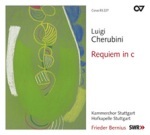Although a contemporary of Mozart, Luigi Cherubini (1760-1842) lived to the age of 81, which means he experienced the fullness of the stylistic changes now known as Romanticism that captured the creative imagination of composers from Beethoven and Schubert to Brahms and Berlioz. Nevertheless, his Requiem in C minor, written for a belated memorial funeral service for the executed Louis XVI (the performance was at Paris’ church of St. Denis in January, 1817), in style, tone, and texture has Mozart written all over it.
Anyone familiar with Mozart’s D minor Requiem will immediately be drawn to the similarities with Cherubini’s work (although no biographical references make any mention of a Mozart/Cherubini connection), particularly its dark color, richly exploited minor-key harmonic palette, and (like Mozart) melodic/dramatic elements suited to a first-rate opera composer (which Cherubini was). Even some of the thematic material is uncannily Mozartean.
But equally notable are the work’s many more “modern” features, such as the surprising tam-tam crash just before the Dies irae, and the subsequent choral movement that to the keen observer may be closer to a refugee from Orff’s Carmina burana or a 20th-century film score than to a movement from an early 19th-century setting of a sacred funereal text.
No matter how you look at it, Cherubini’s music is equal to the final creative gasp of Mozart, or to the more labored choral efforts of Beethoven (he regarded Cherubini as the greatest living composer–after himself–and requested this Requiem at his own funeral). Frieder Bernius and his excellent choir and orchestra present the finest rendition of the C minor Requiem yet recorded–signified by taut ensemble and scintillating harmonies and vibrant, dynamic textures that confirm Cherubini’s solid, successful communion of text and musical ideas.
Highlights include the entire Offertorium sequence, but especially the sensitive expression of the lovely passages of the Hostias, along with the energetic and texturally well-delineated fugues and finely articulated orchestral playing. Unlike Mozart’s work Cherubini’s contains no solo vocal parts, and we don’t miss them (not to disparage the former’s masterful creations)–the entire piece is no more than 45 minutes long, and every bar seems efficiently, purposefully written.
My only complaint–other than the sound that very occasionally obscures inner detail of the choral parts–is the insertion of the Tractus “Absolve, Domine” (nevertheless beautifully sung by the Gregorian chant experts Schola Gregoriana Tübingen) just before the Dies irae, thus negating the stunning effect of the brass signal and tam-tam crash following the subdued ending of the Gradual. There’s no explanation of this insertion in the notes, although there is a pointed reference to the dramatic effect of the brass/tam-tam transition directly from the Gradual to the Dies irae.
However, if these are our only criticisms we are indeed fortunate; this is a marvelous performance of a shamefully neglected work. When you hear how beautiful and finely crafted it is you can only ask, if we can so readily perform a non-authentic, incomplete work by Mozart without a shrug, what’s wrong with a totally authentic masterpiece by a reputable and highly talented contemporary–and you don’t even need to hire a soloist? Listen to this and you will be converted. Highly recommended. [9/8/2010]
































